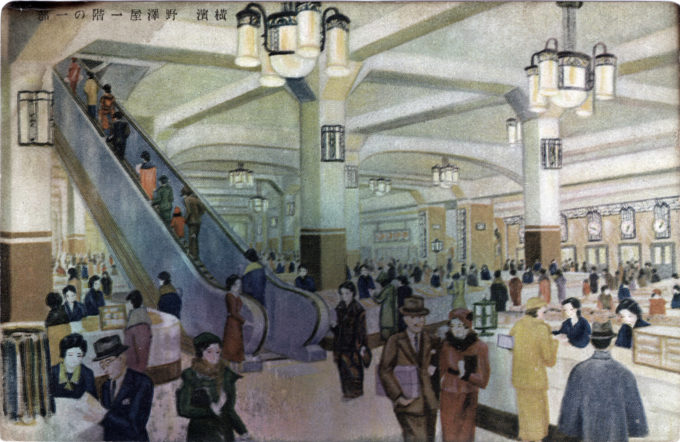See also:
Nozawa & Bros. department store, Yokohama, c. 1940.
Isetan Department Store, Shinjuku, c. 1935
Matsuzakaya Department Store, Ueno, c. 1907-1940
Mitsukoshi Department Store, c. 1903-1923
Shirokiya Department Store, c. 1910-1940
“In Japan the modern department store emerged in the first decade of the twentieth century as an end product of ‘civilization and enlightenment’ (bunmei kaika), a phrase coined in 1867 by Fukuzawa Yukichi.
“… In the goods that it sold, in the services and various forms of entertainment that it provided, and in the values that it projected, the department store reflected the new hybrid culture’s identification with appearances and material possessions, reaffirmed and spurred on that culture’s dedication to productivity and to catching up with the west, and personified the new modern intelligentsia’s aspirations for enrichment, self-fulfillment and gracious living during the Taisho democracy (1912-1926).”
– Asian Department Stores, by Kerrie L. MacPherson, 2013

The major Tokyo department stores, c. 1930. Clockwise, from top-left: Matsuzakaya (Ueno), Shirokiya (Nihonbashi), Isetan (Shinjuku), Takashimaya (Nihonbashi). At center is Mitsukoshi (Nihonbashi).
“In the important cities of Japan today there are large department stores with huge capital investments, some of them being capitalized at more than one hundred million yen. These establishments have become indispensable to the people of Japan, particularly to the urban population. Then, too, it might be said that they are the pride of one phase of the cultural life of present-day Japan.
“… Every conceivable variety and kind of articles is on sale in the Japanese department store – from clothes for the new-born babe to mortuary tablets. Large stocks of virtually all the needs, comforts and luxuries of everyday life are kept by all stores. In Japanese, the department store is called ‘hyakka-ten‘, literally ‘the store of a hundred articles’. As a matter of fact, however, it should be rightly called ‘the store of hundreds of thousands of articles’:
“Native Japanese provisions, such as rice, soy-bean sauce, ‘miso‘ (bean paste), sugar, etc., as well as imported foodstuffs for a Western-style meal; fuel, such as coal and charcoal; clothing which the Japanese by custom change with the four seasons of the year, in particular the fair sex, for whom material is specially designed and dyed to order in a blaze of colors according to their tastes; gorgeous bridal costumes; paintings and other works of applied and industrial arts by the foremost masters; precious jewels and gems gathered not only in Japan but from the corners of the world; plants and flowers and cleverly-made miniature tray landscapes depicting scenes from nature, all of which form a veritable botanical garden; an endless variety of imported articles; Western-style clothes and accessories for men and women; pharmaceutical supplies; cosmetics; travel equipment (trunks, suit-cases, etc.); furniture and household appliances; sporting goods; stationery; even a menageries or miniature zoo, where bear cubs, monkeys, rabbits, squirrels, pigeons, canaries and rare birds from the different countries are found.
“The Japanese department store, however, does not confine itself to the selling of merchandise. For the tens and hundreds of thousands of customers who crowd the store, management offers a variety of attractions and free services. Exhibitions of arts and crafts, of products from all parts of the country and those to stimulate public interest in national affairs are periodically held in the spacious exhibit salons invariably found in the Japanese department store.
“In auditoriums with a seating capacity of from 300 to over 1000, music and dance recitals, motion picture and stage shows and other forms of entertainment, both Japanese and foreign, are presented almost daily and free of charge, thus providing an opportunity to tired shoppers for relaxation and rest. On the roof there is a lovely Japanese garden, complete with fountains, brooks and flower beds, and also a fully-equipped playground for children.
“… With such a surprising range of various attractive displays and inducements, the department store in Japan has come to be a sort of amusement center to a section of the public. The immense throngs which crowd the stores on Sundays and holidays would certainly seem strange to Westerners who consider shopping a matter of business.”
– “Features of the Japanese Department Store”, Travel in Japan, Vol. 5 No. 4, 1939




